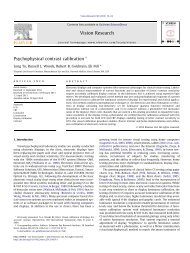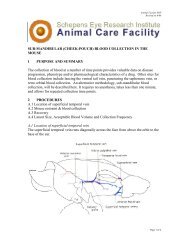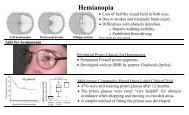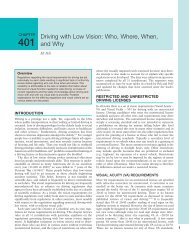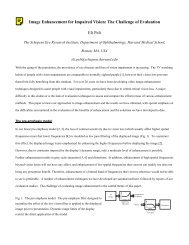In-the-Spectacle-Lens Telescopic Device for Low Vision
In-the-Spectacle-Lens Telescopic Device for Low Vision
In-the-Spectacle-Lens Telescopic Device for Low Vision
You also want an ePaper? Increase the reach of your titles
YUMPU automatically turns print PDFs into web optimized ePapers that Google loves.
ocular elements we used off-<strong>the</strong>-shelf components that were available on hand: a 1 inchpolarizing cube, a quarter wave plate, a mirrored planoconvex lens with rectangular shape(8×15mm), and an occluder to increase contrast. The magnification obtained was 2.9×, as <strong>the</strong>ratio of <strong>the</strong> mirrors’ radii.The folding/erecting flat mirrors described in <strong>the</strong> terrestrial version were not included so <strong>the</strong> finalimage was inverted (Fig. 13). The final image was colored since <strong>the</strong> off-<strong>the</strong>-shelf beam splitterthat we used was tuned <strong>for</strong> infrared applications, instead of visible broadband. <strong>In</strong> Fig. 13c weillustrate Simulvision obtained by simply tilting <strong>the</strong> ocular beam splitter.Figure 12: A prototype implementing an astronomical Keplerian telescope usingpolarizing beam splitters and spherical mirrors. The objective assembly (top) iscomposed from <strong>the</strong> magnifying element of a MicroOptical display system whichincludes a polarizing beam splitter, a quarter wave plate, and a spherical mirror (top).The ocular assembly (below) is constructed from a polarizing cube beam splitter, aquarter wave plate and a conventional plano-convex lens that was silvered on <strong>the</strong>convex surface. A dark occluder is visible behind <strong>the</strong> image of <strong>the</strong> ocular sphericalmirror21




